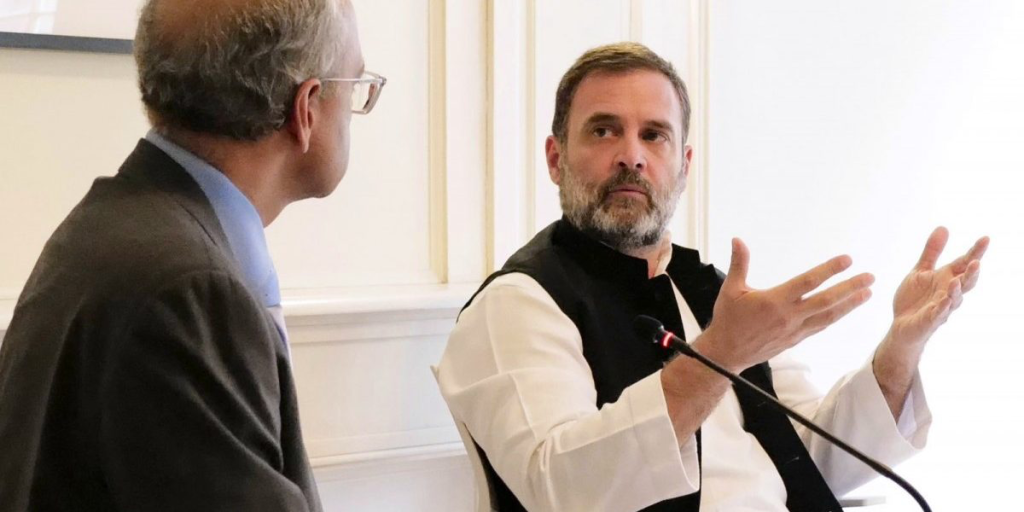The fact that the planned joint opposition in Patna was postponed has created rumours that such unity may not be achieved before 2024. This fear, however, is almost certain to prove groundless.

Rahul Gandhi at Roosevelt House, New York. Photo: Twitter/@RahulGandhi
The postponement of the the grand opposition meeting that had been scheduled for June 12 in Patna to June 23 has revived anxiety in India’s civil society that this could signal second thoughts in the Congress on the terms on which the unity need to be forged. This is in spite of Congress president Mallikarjun Kharge having stressed the importance of uniting to fight the BJP in 2024, in his inaugural address to the AICC in Raipur three months ago, where he had advocated the formation of an alliance based on the ‘UPA model’ of 2004–2014, and had cautioned the rest of the opposition against forming a ‘Third Front’.
Since then, however, talk of a UPA-type alliance has almost disappeared from the Congress’s political lexicon, but no alternative proposal for government formation in the event of an opposition victory has taken its place. It is not surprising therefore that the postponement of the grand opposition meeting scheduled to take place in Patna on June 12 to June 23, has once again aroused dormant fears that a formula for unity might still elude the opposition when decision time arrives.
This fear, however, is almost certain to prove groundless. The evidence for this, if any were needed, is to be found in the speeches of Rahul Gandhi during his six-day interaction with the Indian diaspora in the US, and question-answer sessions that followed. Thanks to Youtube, all of these can be seen in their entirety by those who were not physically present. So we are in a position, unique in human history, of being able to judge a speaker’s sincerity and character in a way that was unthinkable even half a century ago. And ever since he began his Bharat Jodo Yatra, Gandhi has been passing this eyeball test with flying colours.
In his speeches in the US, Gandhi displayed a palpable sincerity that is the polar opposite of the dissembling and compromise that characterises Indian politics, and for that matter most democratic politics in the world. In all of them his theme was the same – India’s innate strength, its durability and its pride has rested, throughout its history, upon its unquestioning acceptance of, and comfort with, its ethnic diversity and religious pluralism. This comfort, he told his audiences in California, Washington DC and New York, is the secret of the phenomenal success of the Indian diaspora in integrating themselves with their adopted countries. Gandhi reinforced this message through his unaffected display of pride in their achievements in the US .
But the message he hammered home most consistently is the one that is most relevant to India’s future. This was that while the BJP and RSS were constantly harping on a largely imagined past, the need of the hour was to chart India’s path into an uncertain future. In a graphic phrase that bids to rival his ‘nafrat ki bazaar’ aphorism, he likened Modi to someone driving with his eyes glued to the rear-view mirror of his vehicle.
He illustrated this by referring to the train accident in Odisha. Within hours of the disaster, the BJP’s spokespersons were busy pointing out that there had been similar, serious accidents during the Congress’s rule too, and in highlighting a train collision at Ariyalur in November 1956 that had claimed 140 lives. What they chose to ignore was the response of the Nehru government whose railways minister resigned, taking constitutional responsibility for the tragedy. Even though the technology for avoiding such tragedies that the world has today had not even been dreamed of then. By contrast, no minister in Modi’s government has done so today, even though that technology has been in general use for decades.
What makes this omission inexcusable is that at the tail end of the UPA government’s rule, a committee headed by Sam Pitroda had recommended installing an anti-collision system on all of the 65,000 kilometres of railway lines in India. But till the time of the Odisha accident an entire decade later, the Modi government had installed anti-collision digital equipment on only 1,000 km of railway lines.
In 1956, the Congress minister who took responsibility and resigned was Lal Bahadur Shastri. The party remembered this and made him India’s prime minister after Nehru’s death.
Perhaps the most striking feature of Gandhi’s speeches in the US was their tone. Narendra Modi’s speeches, both at home and abroad, are designed to create awe and fear. Gandhi’s speeches have reflected a desire to start a dialogue. In all of them he has emphasised the need for joint action by political parties in India – not to win an election or throw out a rival political party, but to save India’s ethnically diverse and religiously plural democracy from crashing in ruins.
If there had ever been any doubt left in people’s minds about his motives, this tour of the US should have erased them. For Rahul Gandhi, saving India’s democracy comes first. His personal status within it comes a long, long way second.
This is the understanding of the Congress’s motives today, with which the major opposition parties need to assemble at Patna on June 23.
Read More